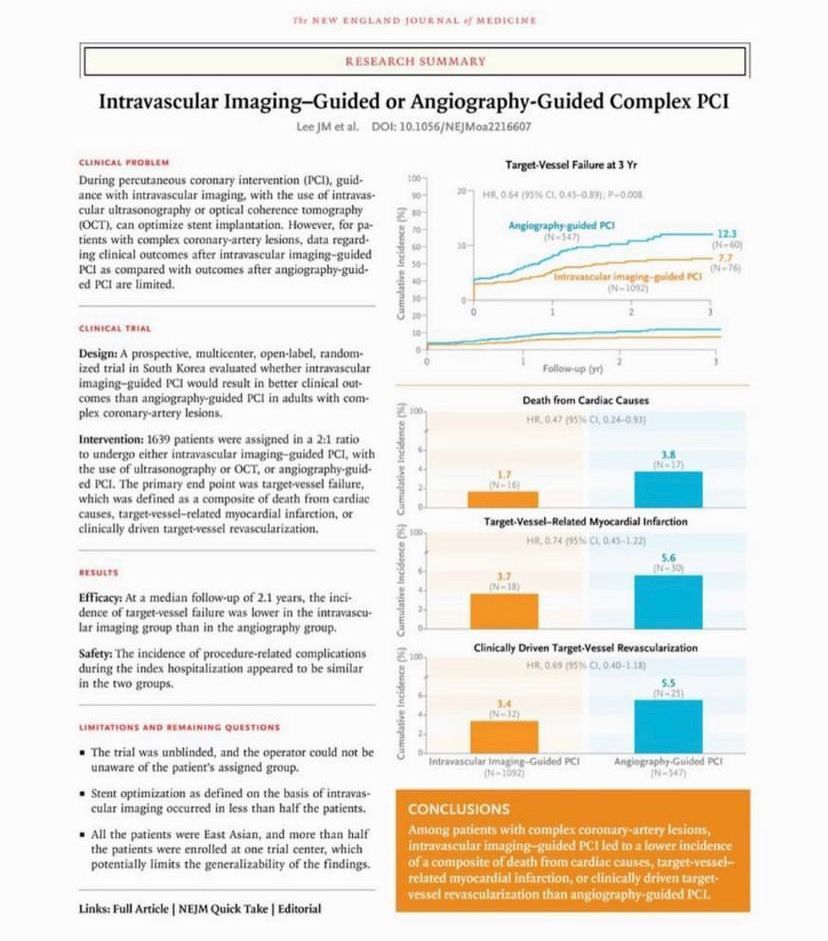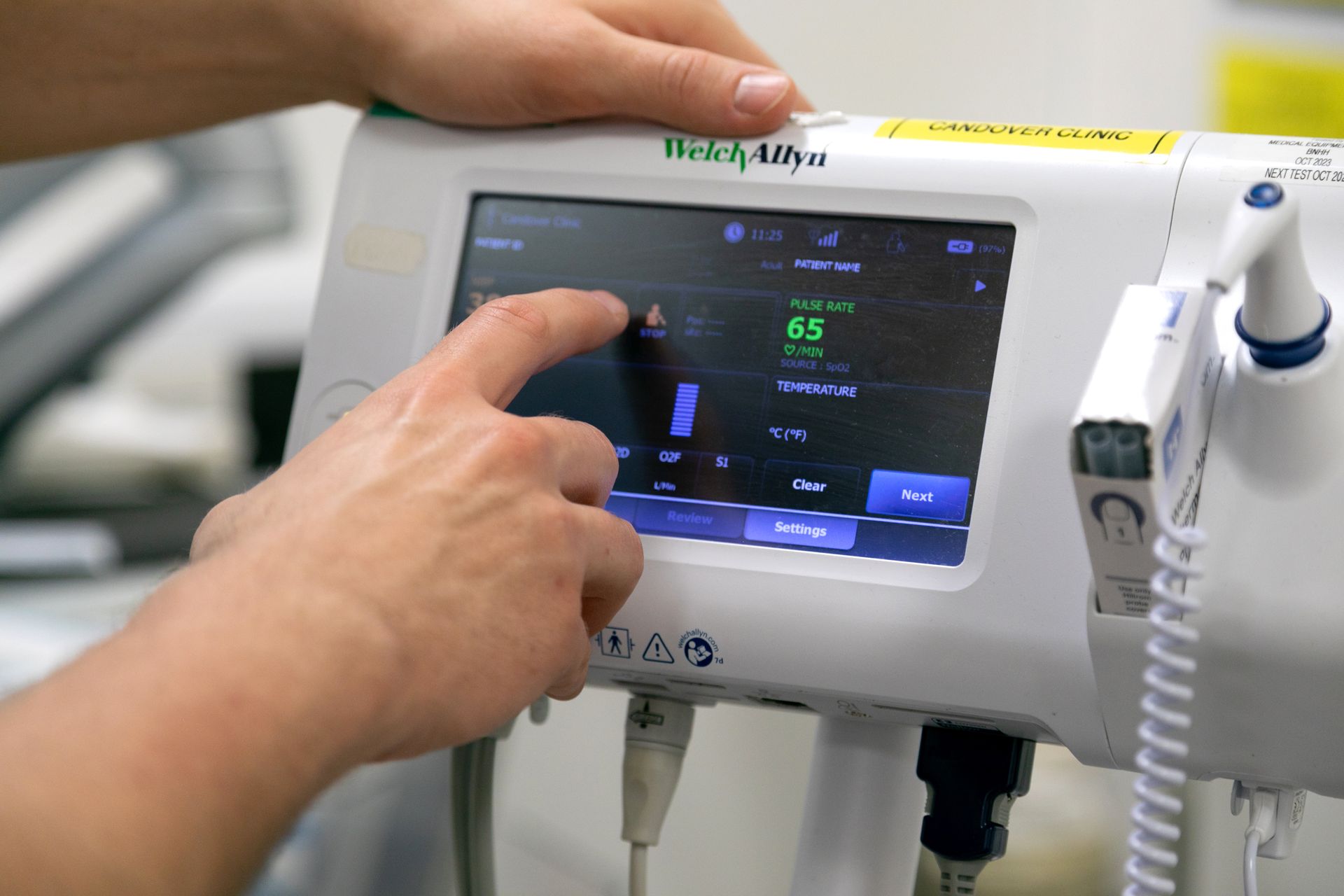IMAGING-guided Stenting led to decrease of Deaths, Myocardial Infarctions and further Stenting in comparison to ANGIOGRAPHY-guided Stenting, according to the this study below.

- This South Korean trial was published in may this year (2023) in New England Journal of Medicine.
- It was a randomised open-label study, which included 1639 participants.
- Both type of Intravascular Imaging were used Intravascular Ultrasound (IVUS) and Optical Coherence Tomography (OCT).
- The patients included had complex coronary disease and the follow-up lasted up to 2.1 years.
The authors concluded: 'Among patients with complex coronary-artery lesions, intravascular imaging-guided PCI led to a lower risk of composite of death from cardiac causes, target vessel-related myocardiac infarction, or clinically driven target-vessel revascularization than angiography-guided PCI.
Intracoronary Imaging: Advancing Cardiac Care Using New Technology.
Introduction:
Intracoronary imaging has revolutionised the field of cardiology by providing detailed visualisation of coronary arteries, facilitating accurate diagnosis and guiding precise interventions. This advanced imaging technique allows cardiologists to assess the extent of plaque build up, identify calcified lesions, and make informed treatment decisions. This article describes the role
of intracoronary imaging in cardiac care, highlighting its benefits, applications, and the availability of private treatment options in Basingstoke (Candover Clinic) and Winchester. By understanding the capabilities of intracoronary imaging and accessing top-quality cardiac services, patients can receive comprehensive and personalized care for their cardiovascular health.
Main Text:
Understanding Intracoronary Imaging:
Intracoronary imaging refers to the use of specialized imaging technologies to visualize the interior of coronary arteries. Two commonly employed intracoronary imaging techniques
are intravascular ultrasound (IVUS) and optical coherence tomography (OCT). IVUS uses sound waves to produce cross-sectional images of the blood vessels, while OCT employs light waves for high-resolution imaging. These imaging modalities offer valuable insights into the structure and composition of coronary arteries, helping cardiologists assess plaque burden, vessel diameter,
and the presence of any vulnerable or unstable plaques.
Benefits and Applications of Intracoronary Imaging:
Intracoronary imaging provides numerous benefits for both diagnostic and interventional purposes. Some key advantages include: a. Accurate Diagnosis: Intracoronary imaging enables cardiologists to accurately assess the severity and location of coronary artery disease. b. Guiding Interventions: During percutaneous coronary interventions (PCI), intracoronary imaging helps guide the placement and optimization of stents, ensuring their proper deployment and
reducing the risk of complications. c. Assessing Plaque Characteristics: Intracoronary imaging allows cardiologists to evaluate plaque composition, including calcified lesions. d. Long-term Monitoring: Intracoronary imaging can be used for long-term surveillance of stented arteries, assessing the vessel's healing process and detecting complications such as restenosis or stent thrombosis.
Accessing Private Treatment in Basingstoke and Winchester:
Patients seeking top-quality cardiac care have private treatment options available in Basingstoke and Winchester. Sarum Road Hospital in Winchester and Candover clinic in Basingstoke are renowned private hospitals in Hampshire, which offer a comprehensive range of cardiovascular services, including consultations with our cardiologist, who specialises in coronary intervention.
Collaborating with a Private Cardiologist:
Engaging the services of a private cardiologist in Basingstoke or Winchester ensures personalised attention and expert guidance throughout your cardiac journey. Our heart specialist possess extensive experience in coronary intervention, intracoronary imaging and is equipped with the skills to interpret and utilize the obtained images effectively. He works closely with patients to develop tailored treatment plans, incorporating intracoronary imaging results for optimal
decision-making and intervention.
The Importance of Timely Intervention:
Private treatment options and access to top cardiologists in Basingstoke and Winchester facilitate
prompt evaluation, accurate diagnosis, and timely intervention, ensuring comprehensive cardiac care.
Conclusions:
Intracoronary imaging has emerged as a valuable tool in modern cardiology, providing detailed visualisation of coronary arteries and enhancing diagnostic accuracy and treatment precision. With private treatment options available in Basingstoke and Winchester, patients can access top-quality cardiovascular care, including at Sarum Road Hospital and Candover clinic. Collaborating with a private cardiologist ensures personalized attention and expert guidance throughout the cardiac care journey.











